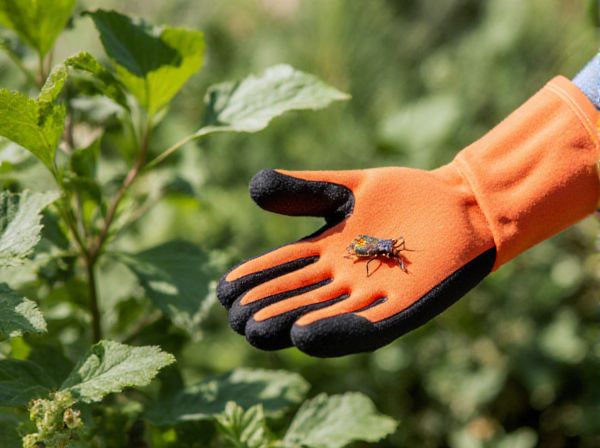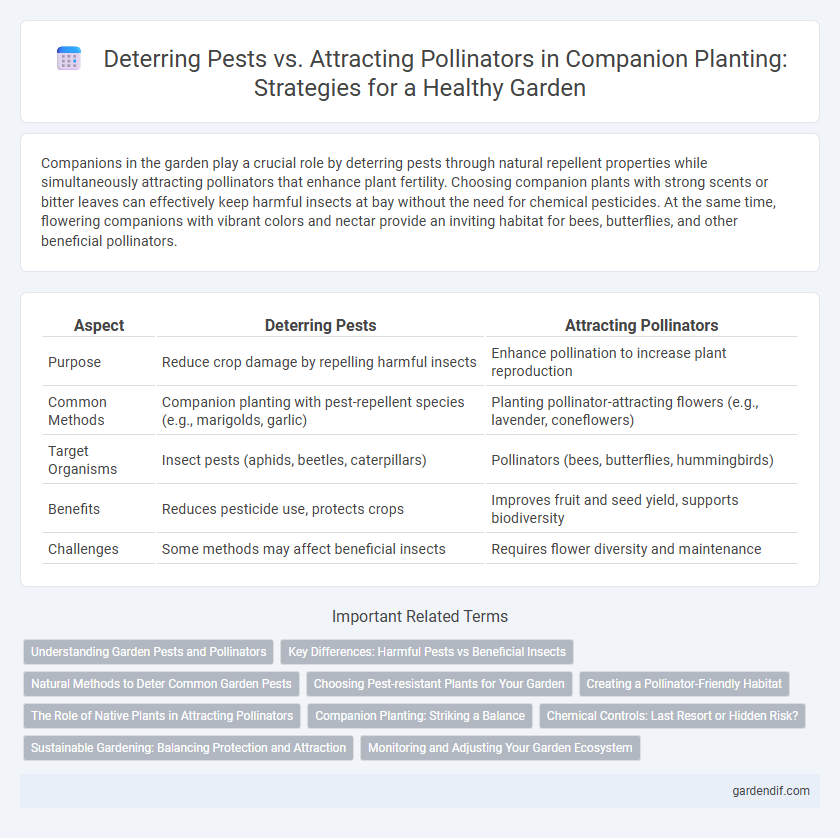
Deterring pests vs attracting pollinators Illustration
Companions in the garden play a crucial role by deterring pests through natural repellent properties while simultaneously attracting pollinators that enhance plant fertility. Choosing companion plants with strong scents or bitter leaves can effectively keep harmful insects at bay without the need for chemical pesticides. At the same time, flowering companions with vibrant colors and nectar provide an inviting habitat for bees, butterflies, and other beneficial pollinators.
Table of Comparison
| Aspect | Deterring Pests | Attracting Pollinators |
|---|---|---|
| Purpose | Reduce crop damage by repelling harmful insects | Enhance pollination to increase plant reproduction |
| Common Methods | Companion planting with pest-repellent species (e.g., marigolds, garlic) | Planting pollinator-attracting flowers (e.g., lavender, coneflowers) |
| Target Organisms | Insect pests (aphids, beetles, caterpillars) | Pollinators (bees, butterflies, hummingbirds) |
| Benefits | Reduces pesticide use, protects crops | Improves fruit and seed yield, supports biodiversity |
| Challenges | Some methods may affect beneficial insects | Requires flower diversity and maintenance |
Understanding Garden Pests and Pollinators
Understanding garden pests and pollinators involves identifying harmful insects like aphids and caterpillars that damage plants versus beneficial ones such as bees and butterflies that enhance pollination. Companion planting can deter pests through natural repellents like marigolds, which discourage nematodes, while attracting pollinators with flowering plants rich in nectar promotes fruit and seed production. Balancing pest control and pollinator attraction optimizes garden health and increases biodiversity.
Key Differences: Harmful Pests vs Beneficial Insects
Companion planting strategically deters harmful pests such as aphids, beetles, and caterpillars by using plants like marigolds and garlic that emit repellent compounds, reducing crop damage and the need for chemical pesticides. In contrast, attracting beneficial insects like bees, butterflies, and ladybugs involves planting flowers such as lavender and dill, which provide nectar and habitat essential for pollination and natural pest control. The key difference lies in targeting specific species: repelling detrimental pests to protect crops while encouraging beneficial pollinators to enhance biodiversity and ecosystem health.
Natural Methods to Deter Common Garden Pests
Natural methods to deter common garden pests include planting companion species such as marigolds, which release compounds that repel aphids and nematodes, and basil, known to keep mosquitoes and flies at bay. Introducing predatory insects like ladybugs and lacewings naturally controls aphid populations without harmful chemicals. Using neem oil or garlic sprays strengthens plants' defenses against caterpillars and beetles while promoting a healthy garden ecosystem that attracts beneficial pollinators.
Choosing Pest-resistant Plants for Your Garden
Selecting pest-resistant plants enhances garden health by minimizing damage from insects and diseases without chemical interventions. Incorporating species like marigolds, lavender, and chrysanthemums naturally deters common pests while supporting beneficial insects. This strategic choice promotes a balanced ecosystem, reducing the need for pesticides and encouraging pollinator activity.
Creating a Pollinator-Friendly Habitat
Creating a pollinator-friendly habitat involves planting a diverse range of flowering plants that bloom at different times to provide continuous nectar and pollen sources. Native plants are essential for supporting local pollinator species such as bees, butterflies, and hummingbirds, which contribute to the ecosystem's health and biodiversity. Keeping the area free from pesticides and providing sheltered nesting sites further enhances the habitat's attractiveness for pollinators while deterring harmful pests naturally.
The Role of Native Plants in Attracting Pollinators
Native plants play a crucial role in attracting pollinators by providing essential nectar and pollen resources that are well-adapted to local insect species. Their evolutionary relationship with native pollinators enhances pollination efficiency, supporting biodiversity and ecosystem stability. Incorporating native plants into companion planting strategies deters pests naturally while promoting healthy pollinator populations critical for crop yield.
Companion Planting: Striking a Balance
Companion planting strategically combines pest-deterring plants like marigolds and nasturtiums with pollinator-attracting species such as lavender and borage to enhance garden productivity. This balance supports natural pest control while boosting pollination, resulting in healthier crops and higher yields. Effective companion planting maximizes biodiversity and creates a sustainable ecosystem within the garden.
Chemical Controls: Last Resort or Hidden Risk?
Chemical controls in companion planting should be considered a last resort due to their potential to disrupt beneficial insect populations, including pollinators vital for ecosystem health. Pesticides often lack selectivity, posing hidden risks by deterring pollinators like bees and butterflies, which are essential for plant reproduction and biodiversity. Sustainable pest management focuses on natural deterrents and habitat-friendly strategies that protect pollinators while minimizing chemical use.
Sustainable Gardening: Balancing Protection and Attraction
Sustainable gardening effectively balances deterring pests while attracting pollinators by selecting companion plants that naturally repel harmful insects and support beneficial species like bees and butterflies. Incorporating herbs such as basil and rosemary near vegetables can reduce pest damage, whereas flowering plants like lavender and marigolds enhance pollinator activity. This strategic plant pairing promotes ecosystem health, reduces chemical pesticide reliance, and boosts overall garden productivity.
Monitoring and Adjusting Your Garden Ecosystem
Monitoring your garden ecosystem regularly helps identify pest populations and pollinator activity, allowing targeted actions to maintain balance. Use tools like yellow sticky traps and visual inspections to detect harmful insects early while observing flower visitation rates to gauge pollinator presence. Adjust plant placement and introduce companion species strategically to deter pests without discouraging beneficial pollinators, ensuring a thriving, productive garden.
Deterring pests vs attracting pollinators Infographic

 gardendif.com
gardendif.com